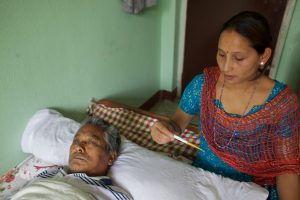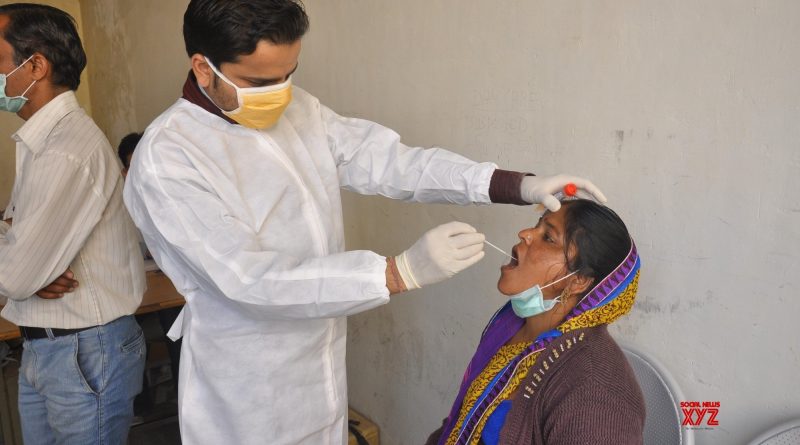Fighting Fatal Flu
Influenza can cause severe illness or death especially in people among high risk groups such as pregnant women, children under 59 months, elderly, and individuals with chronic medical conditions.
By Abhigyan/Abhinav
Seasonality is a long-recognized attribute of many viral infections of humans, but the mechanisms underlying seasonality, particularly for person-to-person communicable diseases, remain poorly understood. Better understanding of drivers of seasonality could provide insights into the relationship between the physical environment and infection risk, which is particularly important in the context of global ecological change in general, and climate change in particular.
 According to Dr Arvind Garg, Senior Child Specialist, Associate with Apollo Hospital, Noida, seasonal influenza is characterized by a sudden onset of fever, cough (usually dry), headache, muscle and joint pain, severe malaise (feeling unwell), sore throat and a runny nose. The cough can be severe and can last 2 or more weeks. Most people recover from fever and other symptoms within a week without requiring medical attention. But influenza can cause severe illness or death especially in people among high risk groups. Illnesses ranges from mild to severe and even death. Worldwide, these annual epidemics are estimated to result in about 3 to 5 million cases of severe illness, and about 290000 to 650000 respiratory deaths.
According to Dr Arvind Garg, Senior Child Specialist, Associate with Apollo Hospital, Noida, seasonal influenza is characterized by a sudden onset of fever, cough (usually dry), headache, muscle and joint pain, severe malaise (feeling unwell), sore throat and a runny nose. The cough can be severe and can last 2 or more weeks. Most people recover from fever and other symptoms within a week without requiring medical attention. But influenza can cause severe illness or death especially in people among high risk groups. Illnesses ranges from mild to severe and even death. Worldwide, these annual epidemics are estimated to result in about 3 to 5 million cases of severe illness, and about 290000 to 650000 respiratory deaths.
Seasonal influenza is a respiratory viral infection with seasonal occurrences every year. In 2019 (till date 03.02.2019), total 6701 cases and 226 deaths from influenza have been reported in the country. Majority of cases have been reported from 11 states (and majority of deaths have been reported from Rajasthan, Gujarat and Punjab). Deaths have been in seen more in persons having morbidities like diabetes, hypertension etc. MOHFW deputed a Public Health Team to states to assess the situation and assist them in strengthening response to the increase in cases. The Secretary has directed additional teams to Gujarat and Punjab to assist the states in response to the outbreak.

The effects of seasonal influenza (H1N1) epidemics in developing countries are not fully known, but research estimates that 99% of deaths in children under 5 years of age with influenza-related lower respiratory tract infections are found in developing countries even in India.
In case of seasonal influenza, patients that are not from a high risk group should be managed with symptomatic treatment and are advised, if symptomatic, to stay home in order to minimize the risk of infecting others in the community. Treatment focuses on relieving symptoms of influenza such as fever. Patients should monitor themselves to detect if their condition deteriorates and seek medical attention Patients that are known to develop severe or complicated illness, should be treated with antiviral medicines in addition to symptomatic treatment as soon as possible.
Strict monitoring of influenza preparedness by the Health Ministry
The Union Health Ministry (MoHFW), claims that regular review is being done on daily basis at the highest level and preparedness and response measures. These have been at the level of HFM, Secretary (Health), DGHS, AS (Health) JS (Public Health) and Director NCDC in 2018-2019. Regular video conferences are being held to monitor the situation. States have been advised to involve district collectors in enhancing public awareness and outbreak response.
 Dr Anup Mohta, Medical Director, Lady Hardinge Medical College, New Delhi, said, “In industrialized countries, most deaths associated with influenza occur among people aged 65 or older. Epidemics can result in high levels of worker/school absenteeism and productivity losses. Clinics and hospitals can be overwhelmed during peak illness periods. People at greater risk of severe disease or complications when infected are: pregnant women, children under 59 months, the elderly, individuals with chronic medical conditions (such as chronic cardiac, pulmonary, renal, metabolic, neuro developmental, liver or hematologic diseases) and individuals with immunosuppressive conditions (like HIV/AIDS, receiving chemotherapy or steroids, or malignancy).”
Dr Anup Mohta, Medical Director, Lady Hardinge Medical College, New Delhi, said, “In industrialized countries, most deaths associated with influenza occur among people aged 65 or older. Epidemics can result in high levels of worker/school absenteeism and productivity losses. Clinics and hospitals can be overwhelmed during peak illness periods. People at greater risk of severe disease or complications when infected are: pregnant women, children under 59 months, the elderly, individuals with chronic medical conditions (such as chronic cardiac, pulmonary, renal, metabolic, neuro developmental, liver or hematologic diseases) and individuals with immunosuppressive conditions (like HIV/AIDS, receiving chemotherapy or steroids, or malignancy).”
In a high powered meeting with senior officers of the Health Ministry, Preeti Sudan, Secretary (HFW) reviewed the state of preparedness and action taken to deal with H1N1 influenza cases, recently. Additional Secretary (Health) Sanjeeva Kumar, DCGI Dr S Reddy, Directors and Senior Officials from NCDC and representatives from EMR were also present in the meeting.
Advisory for preparedness to seasonal influenza A (H1N1) was issued from DGHS, JS (Public Health), and Director NCDC in 2018-2019. Integrated Disease Surveillance Programme (IDSP) and its state units have enhanced the surveillance for Influenza like Illness (ILI) and Severe Acute Respiratory Infections (SARI).
IDSP assisted lab network of 12 laboratories a providing laboratory support in terms of testing, quality assurance, guidance, providing viral transport mediums and diagnostic reagents. The laboratory network of ICMR (41 labs), MoHFW, and states also have identified state government and private laboratories for testing clinical samples of seasonal influenza A (H1N1). In addition, NCDC is providing diagnostic kits and Viral Transport Medium kits to states as per identified need to be used in laboratories/ hospitals identified by state governments.
The states have been asked to follow the MoHFW guidelines (Risk categorization, clinical management protocol, use of masks for healthcare workers, guidelines for vaccination with influenza vaccine and providing home care) of seasonal influenza available at NCDC website (https://ncdc.gov.in/ or https://mohfw.gov.in/media/disease-alerts/Seasonal-Influenza/technical-guidelines).
Dr Suneela Garg, HOD, Department of Com munity Medicine, Maulana Azad Medical College, New Delhi, said, “In terms of transmission, seasonal influenza spreads easily, with rapid transmission in crowded areas including schools and nursing homes. When an infected person coughs or sneezes, droplets containing viruses (infectious droplets) are dispersed into the air and can spread up to one meter, and infect persons in close proximity who breathe these droplets in. The virus can also be spread by hands contaminated with influenza viruses. To prevent transmission, people should cover their mouth and nose with a tissue when coughing, and wash their hands regularly.”
munity Medicine, Maulana Azad Medical College, New Delhi, said, “In terms of transmission, seasonal influenza spreads easily, with rapid transmission in crowded areas including schools and nursing homes. When an infected person coughs or sneezes, droplets containing viruses (infectious droplets) are dispersed into the air and can spread up to one meter, and infect persons in close proximity who breathe these droplets in. The virus can also be spread by hands contaminated with influenza viruses. To prevent transmission, people should cover their mouth and nose with a tissue when coughing, and wash their hands regularly.”
WHO recommendations
Oseltamivir, the drug recommended by WHO, is made available through the Public Health System free of cost for H1N1. Oseltamivir was also made available under Schedule H1 by Govt. of India so that the drugs are readily available to the patients. Drug Controller General of India has been asked to coordinate with drug manufacturers and monitor the drug availability in various states.
All the states have been advised to complete the procurement of required logistics for managing H1N1 from state budget. However, during crisis in states, Govt. of India is supplying logistics (drugs, PPE kits, N-95 face masks). Currently in 2019, Govt. of India has been supplied the logistics to Bihar, Haryana, Himachal Pradesh, Uttar Pradesh, Jammu (J&K), Himachal Pradesh, Delhi, and Punjab.
MoHFW has recommended vaccination for healthcare workers and other priority groups. The guidelines for influenza vaccination have been shared with all states. The details of manufactures of vaccine (as per recommendation of Govt. of India) provided from DCGI, have been shared with all states. Communication material for preventive measures has also been shared with all the states.
There are 4 types of seasonal influenza viruses, types A, B, C and D. Influenza A and B viruses circulate and cause seasonal epidemics of disease.
Influenza A viruses are further classified into subtypes according to the combinations of the hemagglutinin (HA) and the neuraminidase (NA), the proteins on the surface of the virus. Currently circulating in humans are subtype A (H1N1) and A (H3N2) influenza viruses. The A (H1N1) is also written as A (H1N1) pdm09 as it caused the pandemic in 2009 and subsequently replaced the seasonal influenza A (H1N1) virus which had circulated prior to 2009. Only influenza type A viruses are known to have caused pandemics.
Influenza B viruses are not classified into subtypes, but can be broken down into lineages. Currently, circulating influenza type B viruses belong to either B/Yamagata or B/Victoria lineage.
Influenza C virus is detected less frequently and usually causes mild infections, thus it does not pose tough challenges.
Influenza D viruses primarily affect cattle and are not known to infect or cause illness in people.

